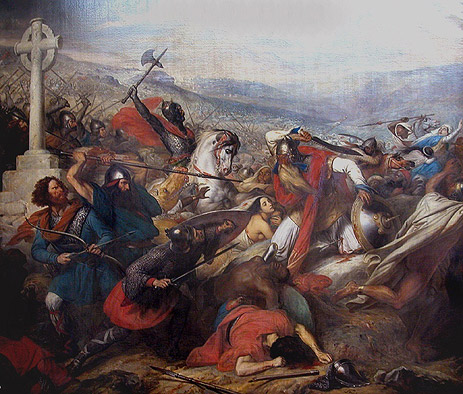Image Resource Bank
Image Gallery |  3 of 15
3 of 15 
Battle of Tours (Battle of Poitiers), 732 CE
Only a hundred years after the death of Muhammad, Ummayad Muslim rulers of what is now Spain led conquering armies into the middle of what is now France. Modern European historians sometimes presented the repulse of the Ummayad forces at Tours by armies of Christian Franks and Burgundians under the command of Charles Martel (“the Hammer”) as the decisive event that saved Western Europe for Christianity. The strategic results of the Frankish victory are debatable. Muslim rulers controlled much of Spain for centuries afterward. Yet the political and cultural consequences were profound, for the Franks’ success, and the later conquests of the Frankish king Charlemagne, laid the groundwork of the Holy Roman Empire in the tenth century CE. The Holy Roman Empire identified Western Europe, the lands that are now France, Germany, and Italy, as the heart of Christendom.
The Celtic cross that dominates this nineteenth-century painting makes plain the artist’s intent to depict the battle as a triumph of Christianity. The exotic presentation of the combatants and victims and the Romantic turbulence of the composition present the Battle of Tours as a historical metaphor, too. Allusions to the French conquest of Algeria in the 1830s, nearly contemporary with the painting, are plain in the skin color of the fleeing Moors, the blue and red garments of the Franks in the foreground that resemble French military colors of the time, and even turmoil of the Moorish cavalry, anticipating Eugène Delacroix’s paintings of North African horsemen, made about twenty years later.
![]() First Ottoman Siege of Vienna (1529) (Siege of Vienna by Ottoman Forces)
First Ottoman Siege of Vienna (1529) (Siege of Vienna by Ottoman Forces)
Name: Battle of Tours (Battle of Poitiers), 732 CE
Material: Oil on canvas
Size:
Width: 5.42 m (17.78 ft)
Height: 4.65 m (15.25 ft)
Date: ca. 1834-1837 CE
Place of Origin: Charles de Steuben
Location: Musée du château de
Versailles, France
Source and Registration#: Wikimedia Commons. Link to resource![]() (accessed August 17, 2009).
(accessed August 17, 2009).

 Matthew W. Stolper
Matthew W. Stolper
Professor of Assyriology and the John A. Wilson Professor of Oriental Studies




